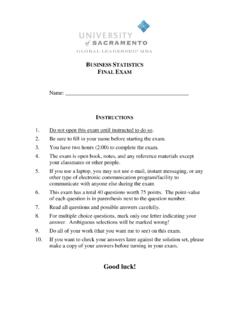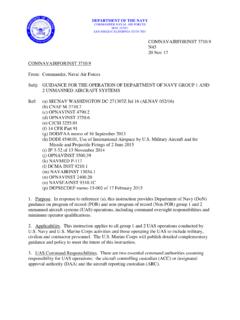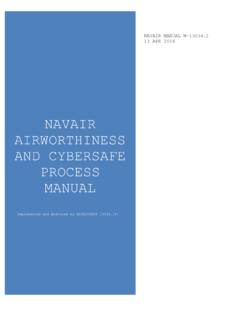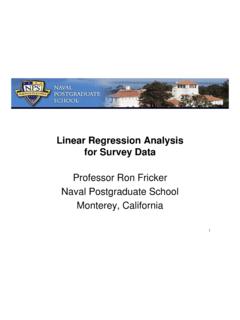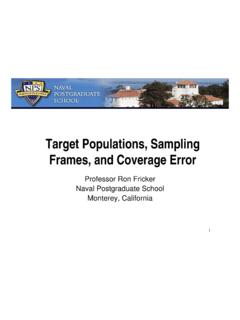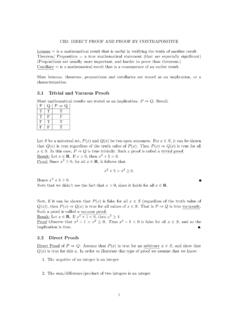Transcription of Radar Fundamentals - Naval Postgraduate School
1 Prof. David JennDepartment of Electrical & Computer Engineering833 Dyer Road, Room 437 Monterey, CA 93943(831) Fundamentals2 Overview Introduction Radar functions Antennas basics Radar range equation system parameters Electromagnetic waves Scattering mechanisms Radar cross section and stealth Sample Radar systems3 Bistatic: the transmit and receive antennas are at different locations as viewed from the target ( , ground transmitter and airborne receiver). Monostatic: the transmitter and receiver are colocated as viewed from the target ( , the same antenna is used to transmit and receive). Quasi-monostatic: the transmit and receive antennas are slightly separated but still appear to be at the same location as viewed from the target ( , separate transmit and receive antennas on the same aircraft).
2 Radio Detection and Ranging TARGETTRANSMITTER (TX)RECEIVER (RX)INCIDENT WAVE FRONTSSCATTERED WAVE FRONTSRtRr 4 Radar Functions Normal Radar functions:1. range (from pulse delay)2. velocity (from Doppler frequency shift)3. angular direction (from antenna pointing) Signature analysis and inverse scattering:4. target size (from magnitude of return)5. target shape and components (return as a function of direction)6. moving parts (modulation of the return)7. material composition The complexity (cost & size) of the Radar increases with the extent of the functions that the Radar SpectrumWavelength ( , in a vacuum and approximately in air)10-310-210-1110-510-410-310-210-1110 1102103104105109108107106105104103102101 100101100101 Frequency (f, cps, Hz)RadioMicronsMetersGigaMegaKiloMicrowa veMillimeterInfraredUltravioletVisibleOp tical300 MHz300 GHzEHFSHFUHFVHFHFMFLFT ypical Radar frequencies6 Radar Bands and Usage8(Similar to Table and Section in Skolnik)7 Time Delay Ranging Target range is the fundamental quantity measured by most radars.
3 It is obtained by recording the round trip travel time of a pulse, TR, and computing range from:where c= 3x108m/s is the velocity of light in free PULSERECEIVED PULSEB istatic: tr RRR cT+=Monostatic: ()2 RtrcTRRR R===8 Classification by FunctionRadarsCivilianMilitaryWeather AvoidanceNavagation & TrackingSearch & SurveillanceSpace FlightSoundingHigh Resolution Imaging & MappingProximity FuzesCountermeasures9 Classification by WaveformRadarsCWPulsedNoncoherentCoheren tLow PRFM edium PRFHigh PRFFMCW("Pulse doppler")CW = continuous wave FMCW = frequency modulated continuous wave PRF = pulse repetition frequencyNote:MTI Pulse Doppler MTI = moving target indicator10 Plane Wavesz1t2txEDIRECTION OF PROPAGATIONoEoE Wave propagates in the zdirection Wavelength, Radian frequency = 2 f (rad/sec) Frequency, f(Hz) Phase velocity in free space is c (m/s) x-polarized (direction of the electric field vector) Eo, maximum amplitude of the waveElectric field vector11 Wavefronts and Rays In the antenna far-field the waves are spherical Wavefronts at large distances are locally plane Wave propagation can be accurately modeled with a locally plane wave approximationPLANE WAVE FRONTSRAYSL ocal region in the far field of the source can be approximated by a plane waveANTENNARADIATIONPATTERNDR2(2/)
4 RD >12 If multiple signal sources of the same frequency are present, or multiple paths exist between a Radar and target, then the total signal at a location is the sum (superposition principle). The result is interference: constructive interference occurs if the waves add; destructive interference occurs if the waves cancel. Example: ground bouncemulti-path can be misinterpreted as multiple of WavesthrhrdtdGrazing Angle, Airborne RadarTarget13 Polarization refers to the shape of the curve traced by the tip of the electric field vector as a function of time at a point in space. Microwave systems are generally designed for linear or circularpolarization. Two orthogonal linearly polarized antennas can be used to generate circular Polarization123456 LINEAR POLARIZATIONELECTRIC FIELD VECTOR AT AN INSTANT IN TIMEORTHOGANALTRANSMITTINGANTENNASELECTR ICFIELDSHORIZONTAL, HVERTICAL, VHORIZONTAL antenna RECEIVES ONLY HORIZONTALLY POLARIZED RADIATION1234 CIRCULAR POLARIZATION14 antenna Parameters Gain is the radiation intensity relative to a lossless isotropicreference.
5 Fundamental equation for gain: In general, an increase in gain is accompanied by a decrease in beamwidth, and is achieved by increasing the antenna size relative to the wavelength. With regard to Radar , high gain and narrow beams are desirable for long detection and tracking ranges and accurate direction , effective area = aperture area efficiency (01)/, wavelengtheeGAAAAcf === =Low gain High gain(Small in wavelengths) (Large in wavelengths) antenna DIRECTIONAL RADIATION PATTERNA perture area15 Half power beamwidth, HPBW ( B) Polarization Sidelobe level antenna noise temperature (TA) Operating bandwidth Radar cross section and other signaturesAntenna Parameters0 MAXIMUM SIDELOBE LEVELPEAK GAINGAIN (dB) sPATTERN ANGLE SCAN ANGLEHPBW3 dB0 MAXIMUM SIDELOBE LEVELPEAK GAINGAIN (dB)
6 SPATTERN ANGLE SCAN ANGLEHPBW3 dBRectangular dB pattern voltage pattern plot16 Airborne applications: > Size, weight, power consumption> Power handling> Location on platform and required field of view > Many systems operating over a wide frequency spectrum> Isolation and interference> Reliability and maintainability> Radomes ( antenna enclosures or covers) Accommodate as many systems as possible to avoid operational restrictions (multi-mission, multi-band, etc.) Signatures must be controlled: Radar cross section (RCS), infrared (IR), acoustic, and visible (camouflage) New antenna architectures and technologies> Conformal, integrated> Digital smart antennas with multiple beams> BroadbandRadar antenna Tradeoffs17 Radar Range Equation Quasi-monostatic2 transmit power (W)received power (W)transmit antenna gainreceive antenna gainradar cross section (RCS, m ) effective aperture area of receive antennatrtrerPPGGA ======RTXPtGtRXPrGr Pr=PtGt Aer(4 R2)2=PtGtGr 2(4 )3R418 Minimum Detection Range The minimum received power that the Radar receiver can "sense" is referred to a the minimum detectable signal(MDS) and is denoted.
7 Given the MDS, the maximum detection rangecan be obtained: SminRPrPr 1/R4 RmaxSminPr=Smin=PtGtGr 2(4 )3R4 Rmax=PtGtGr 2(4 )3 Smin 1/419 Radar Block Diagram This receiver is a superheterodynereceiver because of the intermediate frequency (IF) amplifier. (Similar to Figure in Skolnik.) Coherentradar uses the same local oscillator reference for transmit Systems Radar coordinate systemsspherical polar: (r, , )azimuth/elevation: (Az,El) or The Radar is located at the origin of the coordinate system ; the Earth's surface lies in the x-yplane. Azimuth ( ) is generally measured clockwise from a reference (like a compass) but the spherical system azimuth angle ( )is measured counterclockwise from the xaxis. Therefore( , ) =360 =90 CONSTANT ELEVATIONxyz ZENITHHORIZON P rTarget Constant El cut Constant Az cut Radar21 Radar Display TypesRANGE (TIME)RECEIVED POWERTARGET RETURNAZIMUTHRANGE0-180180 TARGET BLIP"A" DISPLAY"B" DISPLAY"C" DISPLAYPLAN POSITION INDICATOR (PPI)AZIMUTHELEVATION0-180180 TARGET BLIP090 RANGE UNITSRADAR AT CENTERAZIMUTHTARGET BLIP22 Pulsed Waveform In practice multiple pulses are transmitted to:1.
8 Cover search patterns2. track moving targets3. integrate (sum) several target returns to improve detection The pulse trainis a common waveformTIME PoTppeak instantaneous power (W)pulse width (sec)1/, pulse repetition frequency (PRF, Hz)interpulse period (sec) number of pulsesopppPfTTN =====23 Range Ambiguities For convenience we omit the sinusoidal carrier when drawing the pulse train When multiple pulses are transmitted there is the possibility of a range ambiguity. To determine the range unambiguously requires that . The unambiguousrangeis TIME PoTpTIME TRANSMITTED PULSE 1 TRANSMITTED PULSE 2 TARGET RETURNTR1TR2Tp 2 RcRu=cTp2=c2fp24 Range Resolution Two targets are resolved if their returns do not overlap.
9 The range resolution corresponding to a pulse width is . R=R2 R1=c /2c /2c c /2 TIME STEP 1 TIME STEP 2 TIME STEP 3 TIME STEP 4toto+ /2to+ to+3 /2R1R2R1R1R1R2R2R2 TARGET25 Range Gates Typical pulse train and range gates Analog implementation of range gates L123M L123M L123M L123M LDWELL TIME=N/PRFM RANGE GATEStTRANSMIT PULSESRECEIVER. M M SIGNAL PROCESSOROUTPUTS ARE CALLED "RANGE BINS" Gates are opened and closed sequentially The time each gate is closed corresponds to a range increment Gates must cover the entire interpulse period or the ranges of interest For tracking a target a single gate can remain closed until the target leaves the bin26 Clutter and InterferenceTXRXTARGETGROUNDMULTIPATHDIR ECT PATHCLUTTERINTERFERENCEANTENNA MAIN LOBEGROUNDSIDELOBE CLUTTER IN RANGE GATERANGE GATESPHERICAL WAVEFRONT (IN antenna FAR FIELD)TARGETRAIN (MAINBEAMCLUTTER)GROUND (SIDELOBECLUTTER)
10 The point target approximation is good when the target extent << R27 Thermal Noise In practice the received signal is "corrupted" (distorted from the ideal shape and amplitude) by thermal noise, interference and clutter. Typical return trace appears as follows: Threshold detectionis commonly used. If the return is greater than the detection threshold a target is declared. Ais a false alarm: the noise is greater than the threshold level but there is no target. Bis a miss: a target is present but the return is not RETURNSTIMERECEIVED POWERRANDOM NOISEDETECTION THRESHOLD (RELATED TO S )minAB28 Thermal Noise Power Consider a receiver at the standard temperature, Todegrees Kelvin (K). Over a range of frequencies of bandwidth Bn(Hz) the available noise poweris where (Joules/K) is Boltzman's constant.
